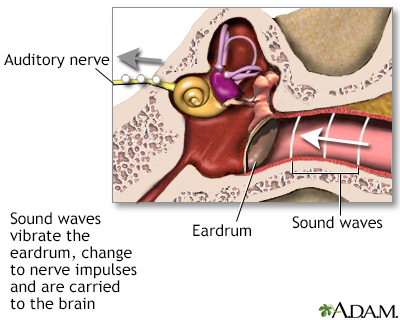Hearing loss and music
Noise induced hearing loss - music; Sensory hearing loss - music

Sound waves entering the ear travel through the external auditory canal before striking the eardrum and causing it to vibrate. The eardrum is connected to the malleus, one of three small bones of the middle ear. Also called the hammer, it transmits sound vibrations to the incus, which passes them to the stapes. The stapes pushes in and out against a structure called the oval window. This action is passed onto the cochlea, a fluid-filled snail-like structure that contains the organ of Corti, the organ for hearing. It consists of tiny hair cells that line the cochlea. These cells translate vibrations into electrical impulses that are carried to the brain by sensory nerves. In this cut-view, you can see the organ of Corti with its four rows of hair cells. There is an inner row on the left and three outer rows on the right. Let's watch this process in action. First, the stapes rocks against the oval window. This transmits waves of sound through the cochlear fluid, sending the organ of Corti into motion. Fibers near the upper end of the cochlea resonate to lower frequency sound. Those near the oval window respond to higher frequencies.

Sound waves travel from the external ear to the middle ear, pass through the eardrum and enter the inner ear where they are interpreted and communicate with neural structures.
Decibels of Sound and Hearing Loss
The decibel (dB) is a unit to measure the level of sound.
- The softest sound that some humans can hear is 20 dB or lower (about the loudness of a whisper).
- Normal talking is 40 dB to 60 dB.
- A rock concert is between 80 dB and 120 dB and can be as high as 140 dB right in front of the speakers.
- Headphones at maximum volume are approximately 105 dB.
The risk of damage to your hearing when listening to music depends on:
- How loud the music is
- How close you may be to the speakers
- How long and how often you are exposed to loud music
- Headphone use and type
- Family history of hearing loss
Activities or jobs that increase your chance of hearing loss from music are:
- Being a musician, sound crew member, or recording engineer
- Working at a night club
- Attending concerts
- Using portable music devices with headphones or ear buds
Children who play in school bands can be exposed to high decibel sounds, depending on which instruments they sit near or play.
When at a Concert
Rolled-up napkins or tissues do almost nothing to protect your ears at concerts.
Two types of earplugs are available to wear:
- Foam or silicone earplugs, available at drugstores, help reduce noise. They will muffle sounds and voices but may fit poorly.
- Custom-fit musician earplugs fit better than foam or silicone ones and do not change the sound quality.
Other tips while in music venues are:
- Sit at least 10 feet (3 m) or more away from speakers
- Take breaks in quieter areas. Limit your time around noise.
- Move around the venue to find a quieter spot.
- Avoid having others shout in your ear to be heard. This can cause further harm to your ears.
- Avoid too much alcohol, which can make you unaware of the pain louder sounds can cause.
Rest your ears for 24 hours after exposure to loud music to give them a chance to recover.
How to Listen to Music on Your iPod or MP3 Player
The small ear bud style headphones (inserted into the ears) do not block outside sounds. Users tend to turn up the volume to block out other noise. Using noise-cancelling earphones may help you keep the volume down because you can more easily hear the music.
If you wear headphones, the volume is too loud if a person standing near you can hear the music through your headphones.
Other tips about headphones are:
- Decrease the amount of time you use headphones.
- Turn down the volume. Listening to music at level 5 or above for just 15 minutes per day may cause long-term hearing damage.
- Do not raise the volume past the halfway point on the volume bar when using headphones. Or, use the volume limiter on your device. This will prevent you from turning the sound up too high.
When to Call the Doctor
If you have ringing in your ears or your hearing is muffled for more than 24 hours after exposure to loud music, have your hearing checked by an audiologist.
See your health care provider for signs of hearing loss if:
- Some sounds seem louder than they should be.
- It is easier to hear men's voices than women's voices.
- You have trouble telling high-pitched sounds (such as "s" or "th") from one another.
- Other people's voices sound mumbled or slurred.
- You need to turn the television or radio up or down.
- You have ringing or a full feeling in your ears.
References
Arts HA, Adams ME. Sensorineural hearing loss in adults. In: Flint PW, Francis HW, Haughey BH, et al, eds. Cummings Otolaryngology: Head and Neck Surgery. 7th ed. Philadelphia, PA: Elsevier; 2021:chap 152.
Eggermont JJ. Causes of acquired hearing loss. In: Eggermont JJ, ed. Hearing Loss. Philadelphia, PA: Elsevier; 2017:chap 6.
Le Prell CG. Noise-induced hearing loss. In: Flint PW, Francis HW, Haughey BH, et al, eds. Cummings Otolaryngology: Head and Neck Surgery. 7th ed. Philadelphia, PA: Elsevier; 2021:chap 154.
National Institute on Deafness and Other Communication Disorders website. Noise-induced hearing loss.
Version Info
Last reviewed on: 5/2/2024
Reviewed by: Josef Shargorodsky, MD, MPH, Johns Hopkins University School of Medicine, Baltimore, MD. Also reviewed by David C. Dugdale, MD, Medical Director, Brenda Conaway, Editorial Director, and the A.D.A.M. Editorial team.
